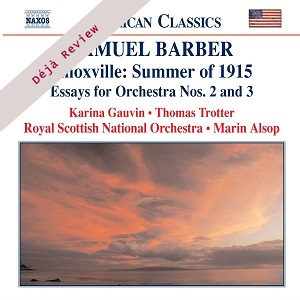
Déjà Review: this review was first published in September 2004 and the recording is still available.
Samuel Barber (1910-1981)
Knoxville: Summer of 1915, Op 24
Second Essay for Orchestra, Op 17
Third Essay for Orchestra, Op 47
Toccata Festiva, Op 36
Karina Gauvin (soprano)
Thomas Trotter (organ)
Royal Scottish National Orchestra/Marin Alsop
rec. 2001/02, Henry Wood Hall, Glasgow & Paisley Abbey, Glasgow
Naxos 8.559134 [57]
Marin Alsop’s excellent Barber series for Naxos continues with this interesting mixed programme. She included the First Essay, Op 12 on an earlier volume that also featured both of Barber’s symphonies (Naxos 8.559024) and now completes the set. Barber’s use of the term “Essay” is most apposite, for all three works seem to me to enshrine the principle of saying what you have to say quickly and economically. The Second Essay was written in 1942, four years after the First. It’s a compressed, pithy piece which combines powerful music with the more lyrical side of Barber in an amazingly short time span. Alsop does it very well. She is equally sure-footed in the Third Essay. This is a late work, written for Eugene Ormandy and the Philadelphia orchestra in 1976. It’s a tougher, terser proposition than the previous Essays and I don’t find it as approachable, but I’m sure that’s my fault.
There’s a Philadelphia connection with the Toccata Festiva also. It was written in 1960 to a commission to inaugurate a new organ in the city’s Academy of Music. This is not one of Barber’s better-known works, no doubt due to the forces involved and also possibly because it’s something of a pièce d’occasion. I was delighted to hear Simon Preston play it during the Last Night of the Proms to show off the refurbished Royal Albert Hall organ. This is the only time I’ve heard the work ‘live’. Actually, the title is something of a misnomer, suggesting as it does a brilliant showpiece. In fact, although the work begins in such a vein, as early as 1’13″ in this performance the music relaxes into a rather subdued lyrical episode that lasts until 4’48″ and there are more quiet sections later on. It seems to me that Barber may have been more interested in exploring sonorities in the work than in writing a crowd-pleasing display piece. (I think I’m right in saying that he specified the organ registrations himself.) For all that, it’s a virtuoso test for both soloist and orchestra. Thomas Trotter gives a commanding performance and the many technical difficulties clearly hold no terrors for him. The piece contains a fearsome cadenza to be played on pedals alone. I’m somewhat surprised by the annotator’s comment that this is “a feat which baffles even the most accomplished of performers.” Certainly Trotter sounds anything but baffled.
This strikes me as a fine performance. However, there’s a bit of a drawback in that the recording was made in a very different acoustic from the remainder of the programme. Paisley Abbey is a much more resonant building than the Henry Wood Hall and the sound is more distant. This is a pity, for not all detail registers with crystal clarity. As it happens there is at least one alternative, a LINN recording made in 2000 by Dame Gillian Weir with the English Chamber orchestra under Raymond Leppard. Here, working in what I imagine is a smaller building, the chapel of Tonbridge School, Kent, the engineers have balanced the performers much more closely, but not aggressively so. The result is pretty spectacular and Barber’s sonorities and, in particular, his powerful register with immense power. This LINN recording (CKD 160) is more specialist as the programme consists entirely of concertante organ works, including the Poulenc concerto. However, anyone who wishes to explore this Barber piece further having heard Trotter’s fine account of it should investigate the artistically and sonically excellent LINN version.
Most purchasers will be attracted especially by Knoxville, I suspect. Fortunately, this Naxos performance is a winner. I’d not encountered the Canadian soprano. Karina Gauvin, before but on this evidence she’s a pretty impressive performer. She faces formidable competition, including the original interpreter of the piece, Eleanor Steber (on Sony, a version I suspect is no longer available). There’s also the great Leontyne Price on BMG/RCA and Dawn Upshaw on Nonesuch. Each of these three singers gives a memorable account of Barber’s highly atmospheric score. Price, I think, does most with the words. Upshaw is very much the Southern girl next door. Steber may strike some as being a bit too formal but hers is a considerable interpretation nonetheless. For me, Gauvin offers perhaps the most in Southern sultriness. Hers by the way is easily the most spacious of these recordings, coming in at 16’52″, followed by Price at 16’18″ with the other two well under 16 minutes. Gauvin sings with beautiful tone, nothing is forced. She excels in the gentle, innocent moments in which this score abounds but when Barber demands vocal power she is suitably equipped. Her diction is superb (though Naxos commendably provide the full text). She is sensitively supported by Marin Alsop. This version is one to rank among the very finest and I enjoyed it greatly. I also admired the great musicianship behind the performance.
This, then, is a worthy successor to Marin Alsop’s previous Barber discs. All four performances are very fine indeed, with that of Knoxville a particularly conspicuous success. I also commend Naxos for their enterprise in including the neglected Toccata. This issue will be a ‘must’ for admirers of Barber’s music and at the advantageous Naxos price it is well worth exploring by general collectors.
Strongly recommended.
John Quinn
Help us financially by purchasing from





















